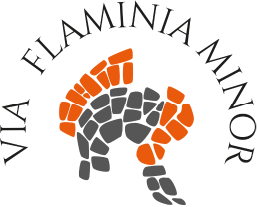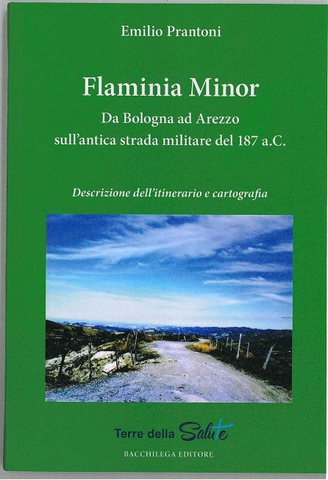itinerario Flaminia Minor
La Via Flaminia Minor, strada romana costruita verosimilmente intorno al 187 a. C., metteva in collegamento Bononia, Claterna e Arezzo. L’itinerario odierno, frutto di un compromesso tra la veridicità storica e la sua effettiva percorribilità, corrisponde per buona parte al sentiero n. 801 del C.A.I. che, partendo da Ozzano dell’Emilia - l’antica Claterna romana - si sviluppa lungo un crinale costituito da calanchi e panorami mozzafiato. La Via Flaminia Minor consente di raggiungere il Passo della Raticosa in Toscana in due giornate di cammino.
La via Flaminia (detta minor o militare) è il nome attribuito da alcuni studiosi a un prolungamento della Via Cassia costruito dal console Caio Flaminio nel 187 a.C. tra Bononia (Bologna) e Arretium (Arezzo), la cui esistenza ci è tramandata da Tito Livio nella Storia di Roma (Libro XXXIX, cap. 2).
Il nome Flaminia minor, o secunda o altera o Flaminia militare, è stato assegnato dagli studiosi per distinguerla dalla via Flaminia tracciata nel 220 a.C. dal padre di Gaio Flaminio, Gaio Flaminio Nepote, per collegare Roma con Rimini.
Il preciso tracciato della strada rimane ancora oggi al centro di un acceso dibattito tra gli storici. Tito Livio parla della costruzione della strada al termine delle operazioni militari per debellare le popolazioni liguri che ancora occupavano l’Appennino, ma non fa parola dell’esatto percorso. La strada certamente collegava Bologna e Arezzo passando per i crinali dell’Appennino.
L’importanza di Claterna (l’attuale Ozzano) posta all’incrocio delle due vie consolari del 187 a.C., la via Emilia e la “Flaminia minore”, la presenza in età medievale di toponimi come Flaminia, Flamenga, Fiamenga e tracce di un’antica via lastricata nell’alta valle del Quaderna fanno presumere che l’itinerario passasse sul crinale tra Idice e Sillaro.
La prima tappa parte da Ozzano nell’Emilia e arriva fino a Villa di Cassano dove, con una breve deviazione dall’itinerario principale, è possibile pernottare.
La seconda tappa della Via Flaminia Minor parte da Villa di Cassano e termina al passo della Raticosa. Presso il Monte delle Carpenine è possibile imboccare il sentiero che scende a San Benedetto del Querceto e tornare a Ozzano con i mezzi pubblici.
La segnaletica ufficiale della Via Flaminia Minor attualmente (ottobre 2022) è presente solo fino al Monte delle Carpenine. Nella parte successiva seguire i segnali CAI 801.
Per conoscere il percorso della Via Flaminia e degli altri percorsi presenti nel terriotorio dell'Unione Savena Idice, è possiible scaricare la carta escursionistica.
La carta escursionistica del territorio del Savena e Idice è uno strumento realizzato a beneficio di camminatori e cicloescursionisti per orientarsi sui sentieri e sui percorsi ciclabili. Include il percorso della Via Flaminia Minor da Ozzano al Passo della Raticosa, 9 itinerari escursionistici e 3 itinerari ciclabili, oltre alla descrizione delle principali attrattive presenti sulla Via Flaminia Minor.
Scarica qui: Carta escursionistica della Via Flaminia Minor e dei percorsi del Savena Idice
Link: Mappa del percorso Flaminia Minor e degli altri Sentieri dell'Unione Savena Idice
Per conoscere tappe, tracciato, cosa vedere e dove dormire lungo la via Flaminia Minor consultare il sito Percorsisavenaidice.it

Venendo da Bologna sulla via Emilia, passata la frazione di Idice, girare a destra sulla rotatoria, prendendo la via Idice fino a Mercatale, frazione di Ozzano Emilia, ove si può ammirare la statua del Cristo in ferro battuto di Eros Mariani sul sagrato della Chiesa nuova, dedicata a San Giovanni Battista. Spostandoci nei pressi incrociamo via del Partigiano con i resti dell'antico borgo. Qui cominciamo la nostra salita lungo la strada Mercatale- Settefonti, dove, percorsi 5 km a sinistra si nota il cartello "Flaminia Minor" che corrisponde al sentiero n. 801 del C.A.I. Si percorre un lungo crinale calanchivo sempre esposto, privo di vegetazione, ma con un panorama mozzafiato e un'aria tersa e pulita. Al termine del sentiero ci si ritrova sulla via Monte Armato da cui proseguendo ci si ricollega a Palesio e Monte Calderaro. Questo sentiero, continuando a salire, ci può portare fino in Toscana, come attestano le fonti antiche. La strada, di origine romana (costruita sembra intorno al 187 a. C.), metteva in collegamento Bononia, Claterna e Arezzo e costituiva una valida alternativa ai percorsi lungo la Valle del Savena e del Reno, ma non va confusa con la Flaminia Militare, ben diversa per scopi, tipologia e ubicazione.
In questi ultimi anni è cresciuto di molto l'interesse verso questo antico percorso da parte dell istituzioni locali e dei ricercatori. In particolare lo storico Emilio Prantoni ha dato alle stampe il primo di due volumi dedicati a questo tema. Il primo volume sostenuto dal Villaggio della Salute+, contiene anche la cartografia, il percorso scaricabile con QR-CODE e si intitola "Flaminia Minor. Da Bologna ad Arezzo sull'antica strada militare del 187 a.C." (Bacchilega editore), di cui si rende la presentazione dell'editore:

"FLAMINIA MINOR. Da Bologna ad Arezzo sull'antica strada militare del 187 a.C." Presentazione dell ‘editore
Il libro propone un itinerario di interesse storico,artistico,pesaggistico e antropologico che ricalca un ipotetico-possibile tracciato della via Flaminia Minor,costruita a scopo militare dal console Gaio Flaminio nel 187 a.C.
L’autore presenta un tracciato completo da Claterna ad Arezzo(Ponte a Buriano) basato su dati storiografici,archeologici,morfologici e antropologici.L’itinerario comprende molte tappe ed antichi monumenti e pievi,fra le più belle del mondo.
La pubblicazione è arricchita da un apparato cartografico che evidenzia il percorso storico,pedonale-ciclabile e automobilistico,nei tratti possibili,col dettaglio delle altimetrie e delle distanze tra le varie località e altre informazioni utili per i viaggiatori
(Seguirà ,nei tempi possibili,una seconda pubblicazione complementare alla prima, riportante il regesto documentativo e la descrizione dettagliata del percorso.)
Link utili:
http://www.sputnik.info/infobofi.htm
https://extrabo.com/it/itinerario/flaminia-minor/
EG
Coming from Bologna on the Via Emilia, past the village of Idice, turn right on the roundabout, taking the Via Idice up to Mercatale, a suburb of Ozzano Emilia, where you can admire the wrought iron statue of Christ by Eros Mariani in the churchyard of the new Church, dedicated to St. John the Baptist. Moving close we cross via del Partigiano with the remains of the ancient village. Here we begin our climb along the way Mercatale- Settefonti, where, after 5 km on the left you can see the sign "Flaminia Minor" that corresponds to the path n. 801 C.A.I. It goes through a long gullies always exposed ridge, devoid of vegetation, but with a breathtaking view and a crisp and clean air. At the end of the path you will find yourself on via Monte Armato continuing from where it links up to Palesio and Monte Calderaro. This path, continuing to rise, can bring up in Tuscany, as they seem to attest to the ancient sources. The road, of Roman origin (seems built around the 187 a.C.), put in connection Bononia, Claterna and Arezzo and constituted a valid alternative to routes along the valley of the Savena and the Reno, but not to be confused with the Flaminia Militare ,very different for purposes, type and site. http://www.sputnik.info/infobofi.htm
In recent years, there has been a growing interest in this ancient route on the part of public institutions (in particular the union of Savena-Idice municipalities) and local researchers. In particular, historian Emilio Prantoni has printed the first of two volumes dedicated to this topic. The first volume, supported by the Villaggio della Salute+, is entitled 'Flaminia Minor. From Bologna to Arezzo on the ancient military road of 187 B.C.'. (Bacchilega editore), of which a presentation note is given below.
Presentation by the publisher: FLAMINIA MINOR
The book proposes an itinerary of historical, artistic, landscape and anthropological interest that traces a hypothetical-possible route of the Via Flaminia Minor, built for military purposes by the consul Gaius Flaminius in 187 BC.
The author presents a complete route from Claterna to Arezzo (Ponte a Buriano) based on historiographic, archaeological, morphological and anthropological data. The itinerary includes many stops and ancient monuments and parish churches, among the most beautiful in the world.
The publication is enriched by a cartographic apparatus highlighting the historical, pedestrian-cycling and automobile route, with details of the altimetry and distances between the various locations and other useful information for travellers.
(A second publication, complementary to the first, will follow in due course, with a documentary record and detailed description of the route).


